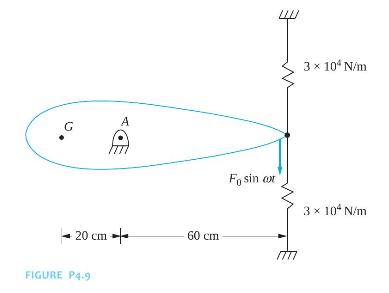The modeling of an airfoil requires at least two degrees-of-freedom. However, its torsional stiffness is unknown, so
Question:
The modeling of an airfoil requires at least two degrees-of-freedom. However, its torsional stiffness is unknown, so an engineer devises a test. She prevents the airfoil from motion in the transverse direction at \(A\) but still allows it to rotate as shown in Figure P4.9. She then places two springs with a stiffness of \(3 \times 10^{4} \mathrm{~N} / \mathrm{m}\) at the tip of the airfoil and excites the airfoil with a harmonic excitation at the tip. She notices that the maximum amplitude of the tip occurs at a frequency of \(150 \mathrm{rad} / \mathrm{sec}\). The mass of the airfoil is \(15 \mathrm{~kg}\), and the moment of inertia of the airfoil about its mass center is \(4.4 \mathrm{~kg} \cdot \mathrm{m}^{2}\). The distance between the mass center and \(A\) is \(20 \mathrm{~cm}\), and the tip is \(60 \mathrm{~cm}\) from \(A\).

Step by Step Answer:






